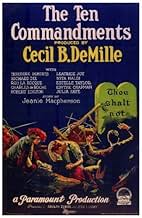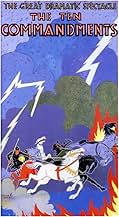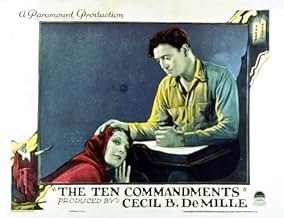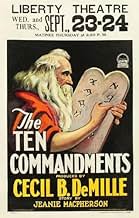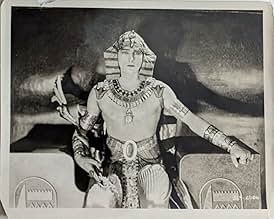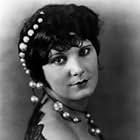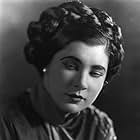IMDb RATING
6.8/10
2.8K
YOUR RATING
After hearing the story of Moses, the sons of a devout Christian mother go their own ways, and the atheist brother's breaking of the Ten Commandments leads to tragedy.After hearing the story of Moses, the sons of a devout Christian mother go their own ways, and the atheist brother's breaking of the Ten Commandments leads to tragedy.After hearing the story of Moses, the sons of a devout Christian mother go their own ways, and the atheist brother's breaking of the Ten Commandments leads to tragedy.
- Director
- Writer
- Stars
- Awards
- 2 wins & 1 nomination total
Charles de Rochefort
- Rameses the Magnificent - Prologue
- (as Charles De Roche)
Pat Moore
- The Son of Pharaoh - Prologue
- (as Terrence Moore)
Leon Beaumon
- Egyptian Calvaryman
- (uncredited)
- Director
- Writer
- All cast & crew
- Production, box office & more at IMDbPro
Featured reviews
It's interesting just to watch DeMille's first, silent film version of "The Ten Commandments", and the picture itself is pretty interesting too. It is also occasionally impressive, sometimes with the kind of DeMille flourishes that one expects, sometimes with a satisfying dramatic turn. It's quite different in its conception from the more familiar 1950's version, and so direct comparisons are not always possible, yet it holds up well by itself anyway.
Rather than concentrating on the biblical story, as in the remake, here DeMille first tells an abbreviated version of the Moses/Exodus narrative, and then uses it as the thematic basis for a modern morality tale. There are many parallels between the two stories, and while the parallels are occasionally forced, they often work surprisingly well. The modern-day story is similar to many other films of the 1910's and 1920's, but it is interesting and it is told well.
Although DeMille is known for his lavish spectacles, he also knew how to create some more subtle effects when he wanted to. In the modern story, some of the developments are a bit contrived, but the characters generally ring true, and the story itself is worthwhile as well. While the lavish remake with color and sound is probably going to remain more well-known, this earlier version is well worth seeing, too.
Rather than concentrating on the biblical story, as in the remake, here DeMille first tells an abbreviated version of the Moses/Exodus narrative, and then uses it as the thematic basis for a modern morality tale. There are many parallels between the two stories, and while the parallels are occasionally forced, they often work surprisingly well. The modern-day story is similar to many other films of the 1910's and 1920's, but it is interesting and it is told well.
Although DeMille is known for his lavish spectacles, he also knew how to create some more subtle effects when he wanted to. In the modern story, some of the developments are a bit contrived, but the characters generally ring true, and the story itself is worthwhile as well. While the lavish remake with color and sound is probably going to remain more well-known, this earlier version is well worth seeing, too.
Today,all his epics ("ten commandments" 1 and 2,"sign of the cross" "Samson and Delilah" ...° have worn remarkably well.
Like many people ,I saw the 1956 version well before the silent one.The prologue (which is very long for a prologue) has a plot similar to the 1956 version from the plagues to the golden calf orgy.Even the Parting of the Red Sea (and it's quite impressive for 1923!) and the writing of the Holy Tablets are here (it looks more like some kind of mystic firework here).As for the orgy,it's simply better than the color version.That said I like that latter version best,because the gap between the biblical tale and the modern one makes that the two parts do not hang very well,in spite of a brilliant transition : Moses and his people saga suddenly segues into a mother reading the Bible to her sons.
The second part will deal with the story of two brothers,one of whom trying to break these "fusty" commandments and not be broken by them. There are interesting parallels: the workers on the building site and the slaves working for pharaoh on the pyramids,the hero who ,like "pharaoh's tribe ,is drowned in the tide" .Little by little,the film becomes slowly but inexorably overtly Christian: the momma hints to carpenters,nice carpenters,there's a short return to biblical times but depicting a scene of Jesus' s life and unlike the bad woman who became a leper in the prologue,salvation is around the corner for the evil millionaire's wife.Lines from St Matthew ("he gained the world but lost his soul") add to this feeling a redemption.
Despite the reservations expressed above,De Mille was a storyteller extraordinaire,who equaled D.W .Griffith .Thou shalt not overlook him.
Like many people ,I saw the 1956 version well before the silent one.The prologue (which is very long for a prologue) has a plot similar to the 1956 version from the plagues to the golden calf orgy.Even the Parting of the Red Sea (and it's quite impressive for 1923!) and the writing of the Holy Tablets are here (it looks more like some kind of mystic firework here).As for the orgy,it's simply better than the color version.That said I like that latter version best,because the gap between the biblical tale and the modern one makes that the two parts do not hang very well,in spite of a brilliant transition : Moses and his people saga suddenly segues into a mother reading the Bible to her sons.
The second part will deal with the story of two brothers,one of whom trying to break these "fusty" commandments and not be broken by them. There are interesting parallels: the workers on the building site and the slaves working for pharaoh on the pyramids,the hero who ,like "pharaoh's tribe ,is drowned in the tide" .Little by little,the film becomes slowly but inexorably overtly Christian: the momma hints to carpenters,nice carpenters,there's a short return to biblical times but depicting a scene of Jesus' s life and unlike the bad woman who became a leper in the prologue,salvation is around the corner for the evil millionaire's wife.Lines from St Matthew ("he gained the world but lost his soul") add to this feeling a redemption.
Despite the reservations expressed above,De Mille was a storyteller extraordinaire,who equaled D.W .Griffith .Thou shalt not overlook him.
Whenever anybody says THE TEN COMMANDMENTS, we think of the fun, uplifting 1956 epic made by DeMille and starring Charleton Heston, Yul Brynner, etc. etc. Not too many people know that film is a remake of DeMille's own 1923 film of the same name. The 1923 version has so much zip to it, mainly because in it's 90 minute plus time, DeMille has to tell TWO stories. The first is the story of Moses. He has to lead the exodus from Egypt, part the Red Sea (an awesome scene done in early two-tone Technicolor) and slap some sense in his followers who wrongly decide to worship the Golden Calf. All that in 45 minutes. That means it spools out really, really fast. The rest of the film takes place in modern day San Francisco, where two brothers, one a hard working carpenter, the other, a wealthy but scheming architect battle. We know their grey haired mom is a good Christian, because she constantly carries around a Bible as big as a cinderblock!
Beautifully restored, witha great piano and organ score. This is an energetic silent well worth catching.
Beautifully restored, witha great piano and organ score. This is an energetic silent well worth catching.
In the early twenties, it was perfectly alright to show sinners revelling extravagantly and unashamedly in the sins of the flesh. All you had to do was either punish or purify them in the end, and everything would turn out just fine. This is the lesson we learn from watching the second half of Cecil B DeMille's gargantuan epic or 1923. And it is the prologue of the movie that teaches us that deMille had more money to spend on his own films than the old man upstairs.
As a lavish production, TTC is probably one of CBdM's greatest achievements, surpassing in quality and size the 1950s remake, Cleopatra (1934) and all billion-or-so versions of The Squaw Man, all of which deMille would directed. His handling of his actors, his attention to detail and unbridled imagination call to mind a time when you could spend whatever amount of money you wanted on a film without being Jerry Bruckheimer.
As a lavish production, TTC is probably one of CBdM's greatest achievements, surpassing in quality and size the 1950s remake, Cleopatra (1934) and all billion-or-so versions of The Squaw Man, all of which deMille would directed. His handling of his actors, his attention to detail and unbridled imagination call to mind a time when you could spend whatever amount of money you wanted on a film without being Jerry Bruckheimer.
'The Ten Commandments' was released in 1923 and was directed by Cecil B. DeMille and is the first of two Ten Commandments films directed by him.
This version differs in more ways than one to the remake. While the remake primarily centers on the story of Moses, the original version only features Moses in the prologue (which runs for approximately 40 minutes). The rest of the film centers on an atheist man in present day (the 1920s) who sets out to break the Ten Commandments in order to become successful.
Comparing to the remake, the special effects in the 'parting of the waves' scene definitely look more realistic here (especially considering this was released in 1923) and the entire prologue I masterfully created - however I do wish it was longer since there was little to no development in the characters because of it's short runtime.
I was initially skeptical about the present day segment of the film but I was thoroughly impressed and the story was definitely intriguing, especially towards the end.
Overall, I do prefer the 1956 remake however you shouldn't turn your back on this one. It is definitely a must-watch, even if it just be for the prologue with Moses.
7/10
This version differs in more ways than one to the remake. While the remake primarily centers on the story of Moses, the original version only features Moses in the prologue (which runs for approximately 40 minutes). The rest of the film centers on an atheist man in present day (the 1920s) who sets out to break the Ten Commandments in order to become successful.
Comparing to the remake, the special effects in the 'parting of the waves' scene definitely look more realistic here (especially considering this was released in 1923) and the entire prologue I masterfully created - however I do wish it was longer since there was little to no development in the characters because of it's short runtime.
I was initially skeptical about the present day segment of the film but I was thoroughly impressed and the story was definitely intriguing, especially towards the end.
Overall, I do prefer the 1956 remake however you shouldn't turn your back on this one. It is definitely a must-watch, even if it just be for the prologue with Moses.
7/10
Did you know
- TriviaThe enormous sets of ancient Egypt have become a Hollywood legend in themselves. The "City of the Pharaohs" was constructed of wood and plaster in the Guadalupe Dunes, an 18-mile stretch of coastal sand 170 miles north of L.A. The sets featured four 35-foot-tall statues of the Pharaoh Ramses, 21 five-ton sphinxes, and city walls over 120 feet high. An army of 2,500 actors, extras, carpenters, plasterers, painters, cooks, staff, and film crew members inhabited the set for three months, housed in a virtual army camp that featured nearly 1,000 tents. (3,500 animals, used in recreating the scenes of ancient Egypt, were housed in a huge corral downwind of the camp.) When shooting wrapped, Cecil B. DeMille simply had the massive Egyptian city sets bulldozed, and buried in a huge pit beneath the sand, where they remain to this day. For years, the legendary "Lost City of DeMille" was spoken of by locals in Guadalupe who had worked on the film set. Artifacts from the Egyptian sets were found in the dunes, and can sometimes be found in local houses in the area. (DeMille even said in his autobiography, "If 1,000 years from now, archaeologists happen to dig beneath the sands of Guadalupe, I hope that they will not rush into print with the amazing news that Egyptian civilization extended all the way to the Pacific Coast of North America.") In 1983, documentary filmmaker Peter Brosnan located the remains of the DeMille sets, still buried beneath the dunes. The site is now recognized as an official archaeological site by the state of California, and it is against the law to remove artifacts from the site. Brosnan has been trying for many years to raise money from the Hollywood studios to excavate the site, but so far has been unable to do so.
- GoofsThe type of staff used by Moses and his followers has a Star of David on the end. The Star of David didn't become a symbol of Judaism until the Middle Ages.
- Quotes
Mary Leigh: I was passing by Dugan's lunch wagon when a hot dog ran out and bit me.
- ConnectionsEdited into Forgotten Commandments (1932)
- How long is The Ten Commandments?Powered by Alexa
Details
Box office
- Budget
- $1,475,837 (estimated)
- Runtime2 hours 16 minutes
- Color
- Sound mix
- Aspect ratio
- 1.33 : 1
Contribute to this page
Suggest an edit or add missing content


